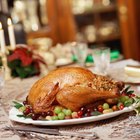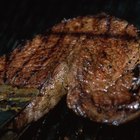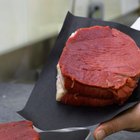
Freezing can keep your food preserved indefinitely, but once you remove food from the freezer the clock begins ticking. Thawing food on the counter can promote the growth of bacteria sufficiently to make you sick. Don't let your food go bad -- instead, follow safe thawing and cooking practices to ensure you never have to throw away food for fear of contamination.
Frozen Raw Meat
Frozen meat should not be left out for more than two hours at room temperature, because this can render it unsafe to eat. There are only three safe ways to thaw raw meat: in the refrigerator, in cold water and in the microwave. Defrosting meat in the refrigerator is the easiest, but takes the most time. Plan on at least one day in the refrigerator for each 5 pounds of weight. To thaw meat in cold water, submerge your meat packaged in a zippered bag into a bowl of cold water; replace water every 30 minutes until the meat is defrosted. Use microwave defrost settings to thaw your meat in the microwave. With microwave and cold water defrosting, it is necessary that you cook the meat immediately upon thawing.
Frozen Cooked Meat
The same rules apply for thawing cooked meats, as well as frozen casseroles containing meat. These items should never be thawed at room temperature, because this can promote the growth of harmful bacteria that causes food-borne illness and spoilage. For cooked meats, thaw in the refrigerator, under cold water or in the microwave. For casseroles, cook from frozen, adjusting the time as needed to both thaw and cook the dish; this is generally about 1 1/2 times the original time when cooking from fresh.
Frozen Vegetables
While frozen vegetables are not as perishable as raw meat, practicing safe handling and thawing is still necessary to prevent harmful bacteria. Frozen vegetables do not need to be thawed before cooking, and cooking from frozen is viewed as the safest way to cook them. If you are making a casserole using frozen vegetables, mix the ingredients while the vegetables are still frozen and increase cooking time as needed to ensure the entire dish is heated throughout.
Refreezing Thawed and Cooked Food
If you have taken out too much meat or change your meal plans, don't let your meat be ruined. If your food is thawed in the refrigerator and not cooked, it is safe to be refrozen, though it may suffer from quality issues due to loss of water. Refreeze any refrigerator-thawed uncooked meat within two days for the best quality. If your cooked food made from frozen food is stored within two hours of cooking, it can also be refrozen for later use. When refreezing leftovers, be sure to freeze them within four days of storage in the refrigerator for the best results.
Related Articles

If Meat Is Frozen, How Long Does It ...

Seasonings for a Turkey Breast
Can You Use Stew Meat That Has Been ...

How to Feed a Large Family Healthy ...

Can You Freeze Meat Twice?

Guidelines For Refreezing

How to Soak Chicken in Cold Water

How to Defrost a Steak and Keep It ...

How Long Can Meat Stay out of the ...

How to Make Dinners Ahead of Time Using ...

Can You Bake Sliders?
Can I Freeze Pork Immediately After ...

Do You Thaw Hamburger Patties Before ...

How to Defrost a Frozen Beef Roast in ...
Can You Freeze Raw Hamburger, Cook It & ...

How to Use a Probe Cooking Thermometer

Do Pork Chops Stay Good When Frozen?

How Fast Does Cooked Spaghetti Squash ...

Can You Make Chicken Fettuccine Alfredo ...

How to Make Dried Meat
References
Writer Bio
Based in Portland, Ore., Maxine Wallace is a writer with more than 12 years of experience. With a bachelor's degree in journalism and experience working on marketing campaigns for large media agencies, she is well-versed in multiple industries including the Internet, cooking, gardening, health, fitness, travel and holistic living.
Photo Credits
Digital Vision./Digital Vision/Getty Images